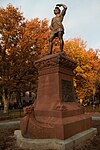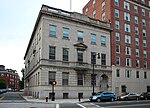Bowker Overpass
1965 establishments in MassachusettsBoston building and structure stubsBridges completed in 1965Bridges in BostonJctint template hatnote tracking category ... and 4 more
Massachusetts transportation stubsNortheastern United States bridge (structure) stubsRoad bridges in MassachusettsSteel bridges in the United States

Philip G. Bowker Overpass is a steel beam bridge with a suspended deck carrying The Charlesgate over Commonwealth Avenue, Beacon Street, and Interstate 90. It connects Boylston Street to Storrow Drive. It runs parallel to the Muddy River. In 2011, there was talk about tearing down the bridge and widening local streets as some consider the bridge to be an eyesore, as well as the fact that it bisects a portion of the Emerald Necklace.
Excerpt from the Wikipedia article Bowker Overpass (License: CC BY-SA 3.0, Authors, Images).Bowker Overpass
Commonwealth Avenue, Boston Fenway / Kenmore
Geographical coordinates (GPS) Address Nearby Places Show on map
Geographical coordinates (GPS)
| Latitude | Longitude |
|---|---|
| N 42.349266666667 ° | E -71.092308333333 ° |
Address
Bowker Overpass
Commonwealth Avenue
02115 Boston, Fenway / Kenmore
Massachusetts, United States
Open on Google Maps










